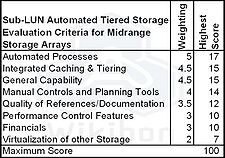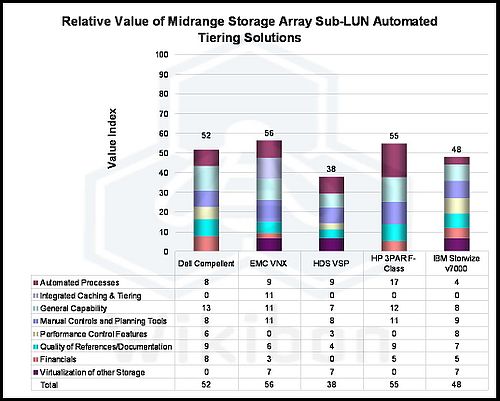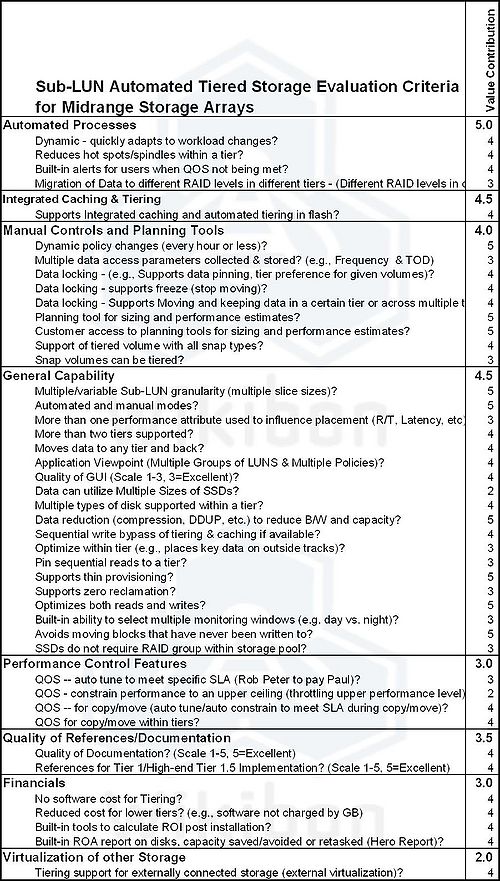Assessment of Automated Tiered Storage for Midrange Arrays
From Wikibon
David Floyer (Talk | contribs) (???ATS Evaluation Criteria & Methodology) |
David Floyer (Talk | contribs) |
||
| Line 48: | Line 48: | ||
#The references that Wikibon talked to were universal in their satisfaction with ATS, and supported the overall findings in terms of savings. The Compellent references were sold that after the initial deployment, all additional storage that would be necessary would be high capacity disk. The references confirmed that this was the case in practice, and could easily show the benefit of ATS with the “hero reports”. | #The references that Wikibon talked to were universal in their satisfaction with ATS, and supported the overall findings in terms of savings. The Compellent references were sold that after the initial deployment, all additional storage that would be necessary would be high capacity disk. The references confirmed that this was the case in practice, and could easily show the benefit of ATS with the “hero reports”. | ||
#Wikibon believes that the major benefit of ATS for the midrange is cost savings, as fewer high-performance disks are required to deliver the same performance. This saving is in the order of 25%. All the ATS implementations could achieve this level of saving, with the exception of the IBM Storwize 7000, which is hampered with supporting only two tiers. | #Wikibon believes that the major benefit of ATS for the midrange is cost savings, as fewer high-performance disks are required to deliver the same performance. This saving is in the order of 25%. All the ATS implementations could achieve this level of saving, with the exception of the IBM Storwize 7000, which is hampered with supporting only two tiers. | ||
| - | #Tools to map today's environment to the future state are lacking and often highly reliant on vendor services to specify the system (pre-installation). As well, post installation performance monitoring tools are rudimentary. This should be a focus for vendors to improve adoption by customers and reduce the sale cycle work for the channel. | + | #Tools to map today's environment to the future state are lacking and often highly reliant on vendor services to specify the system (pre-installation). As well, post installation performance monitoring tools are rudimentary. This should be a focus for vendors to improve adoption by customers and reduce the sale cycle work for the channel. |
| + | #Midrange arrays that do not offer ATS are at a distinct disadvantage in the marketplace. Wikibon expects that the new HUS midrange arrays from Hitachi (replacing the AMS Series) will include ATS functionality in the future. The IBM XIV fundamental architecture precludes that use of flash, which will limit the scope of XIV adoption to situations were only "good enough" IO performance is required. IBM users will have the Storewize 7000 as an alternative, and the Wikibon believes that its functionality should improve with the introduction of more that two tiers, possibly later in 2012. | ||
| + | #The vendor least supportive of ATS is NetApp, which instead only sells the flash-cache PCIe card on the FAS storage arrays. The size of this cache is limited, and does not offer the potential savings of a full ATS implementation, especially against the EMC VNX which offers an integrated flash-cache and ATS. THe NetApp arrays have previously led other arrays in additional storage array function such as compression and de-duplication. Wikibon believes that NetApp need to add ATS functionality to their array offerings to be competitive. | ||
#Missing in the ATS solutions analyzed was the ability to manage quality of service by limiting the maximum IO resources available to volumes and applications. This will become increasingly important as [[IO Tiering for NAND Flash Eliminates Data Movement|flash storage takes over more of IO activity from high-performance disk]]. IO tiering will need to be part of the automation process. | #Missing in the ATS solutions analyzed was the ability to manage quality of service by limiting the maximum IO resources available to volumes and applications. This will become increasingly important as [[IO Tiering for NAND Flash Eliminates Data Movement|flash storage takes over more of IO activity from high-performance disk]]. IO tiering will need to be part of the automation process. | ||
Revision as of 14:56, 19 May 2012
Originating Authors: David Floyer and Nick Allen
In December 2011, Wikibon published research on Automated Tiered Storage (ATS) for Higher-end storage arrays, and concluded that ATS was cost-justified (reduced storage costs by about 25%) and ready for “prime time”. Wikibon found that a key element in the higher-end arrays was control over the environment. Most users, supported by early user experience, were not ready to allow the mission critical applications to be managed by a “black box”.
This follow-on research extends the original research to the midrange marketplace. Automation is more important for this market segment, and Wikibon
Contents |
WORK IN PROGRESS
PLEASE DO NOT EDIT OR TWEET UNTIL THIS BANNER IS DOWN
Executive Summary
Storage Arrays Analysed
Wikibon picked the single most popular platform from each of the major platforms to analyze. The intial list was:
- Dell Compellent using Data Progression
- EMC VNX using FAST VP ATS together with FastCache software
- Hitachi AMS
- Hitachi VSP using Dynamic Tiering ATS software
- HP 3PAR F-Class using Adaptive Optimization ATS software
- IBM Storwize 7000 using Easy Tier ATS software
- IBM XIV
- NetApp FAS Series
Three arrays were not analyzed because they did not offer an ATS solution. They were:
- Hitachi AMS
- Hitachi HUS system – this array family is new into the marketplace. Tiered storage is offered for file-based storage, but not initially for block-based storage. Wikibon expects ATS block-based storage solutions to be available in the future, and hopes to analyze them in the future.
- IBM XIV (Flash can act as a read-only cache. The fundamental architecture of the VIV which spreads two copies of data across all drives only allows a single tier of storage.)
- NetApp FAS Series (Flash acts as a read-only cache. NetApp offer manual movement of data between tiers, but have been resistant to providing an automated tiered storage solution)
The Hitachi VSP and IBM Storwize 7000 were analyzed in the previous research. This time the weightings and the comparison categories and questions were all slightly different.
ATS Evaluation Criteria & Methodology
Wikibon looked at the ATS functionality for midrange arrays required for typical midrange workloads. Wikibon talked extensively to Wikibon members that had implemented or were implementing ATS for mission critical workloads and other workloads. As with the Tier 1 customer that Wikibon talked to, Wikibon found there was high activity and expectation that they would deploy ATS. Wikibon discussed it's members the importance functionality requirements for the midrange. Table 1 gives the evaluation criteria functionality groups that Wikibon developed and used in this analysis, and the relative weightings. Because midrange ATS is often implemented is data centers with limited technical resources, high weightings were given to automation, integration and planning capabilities. Less weighting was given to general capabilities and financials. Table 1 also shows that maximum score that is available within each criteria, with the overall maximum score being set at 100.
Wikibon expects that as products mature and understanding increases with adoption, the evaluation criteria and weightings will change. The requirements and criteria for ATS on other storage array tiers will be different, and it would be misleading to apply the findings of this study to other workloads/storage tiers.
Within each of the evaluation criteria are specific functionalities, as shown in table 2, together with the relative importance within the criterion on a 5 point scale. All of these functionalities are assessed for each of the storage arrays as available/not available (Y/N), except for questions on Quality of GUI and data locking, which are assessed on a three point scale and two questions on quality of documentation and references, which are assessed on a five point scale.
Key Findings
The results for the adoption stage of midrange ATS implementation are shown in figure 1.
Wikibon performed a detailed analysis of vendor specification sheets and requested and conducted interviews with all the vendors included in this study. Wikibon received good support from all the vendors. The key findings of this study include:
- There is a wide range of quality of implementation in the marketplace. The EMC and HP 3PAR F-class were in a statistical dead hear for the top spot, with the Dell Compellent very close behind.
- There is a difference of integration philosophy for the EMC VNX, which integrated the array controller cache, the flash-cache and the ATS functionality. Wikibon believes that this integration is an excellent approach for the midmarket, giving greater overall automation and ease of use.
- The HP 3PAR system had the best automation features of the arrays examined in detail.
- The references that Wikibon talked to were universal in their satisfaction with ATS, and supported the overall findings in terms of savings. The Compellent references were sold that after the initial deployment, all additional storage that would be necessary would be high capacity disk. The references confirmed that this was the case in practice, and could easily show the benefit of ATS with the “hero reports”.
- Wikibon believes that the major benefit of ATS for the midrange is cost savings, as fewer high-performance disks are required to deliver the same performance. This saving is in the order of 25%. All the ATS implementations could achieve this level of saving, with the exception of the IBM Storwize 7000, which is hampered with supporting only two tiers.
- Tools to map today's environment to the future state are lacking and often highly reliant on vendor services to specify the system (pre-installation). As well, post installation performance monitoring tools are rudimentary. This should be a focus for vendors to improve adoption by customers and reduce the sale cycle work for the channel.
- Midrange arrays that do not offer ATS are at a distinct disadvantage in the marketplace. Wikibon expects that the new HUS midrange arrays from Hitachi (replacing the AMS Series) will include ATS functionality in the future. The IBM XIV fundamental architecture precludes that use of flash, which will limit the scope of XIV adoption to situations were only "good enough" IO performance is required. IBM users will have the Storewize 7000 as an alternative, and the Wikibon believes that its functionality should improve with the introduction of more that two tiers, possibly later in 2012.
- The vendor least supportive of ATS is NetApp, which instead only sells the flash-cache PCIe card on the FAS storage arrays. The size of this cache is limited, and does not offer the potential savings of a full ATS implementation, especially against the EMC VNX which offers an integrated flash-cache and ATS. THe NetApp arrays have previously led other arrays in additional storage array function such as compression and de-duplication. Wikibon believes that NetApp need to add ATS functionality to their array offerings to be competitive.
- Missing in the ATS solutions analyzed was the ability to manage quality of service by limiting the maximum IO resources available to volumes and applications. This will become increasingly important as flash storage takes over more of IO activity from high-performance disk. IO tiering will need to be part of the automation process.
There were two major concerns expressed by the midrange users that Wikibon interviewed. They were the same as the Tier 1 customers, but the midrange users were less concerned about them:
- Ensuring that specific workloads would get the performance they required;
- Avoiding the scenario of a “rogue” workload causing the ATS software to make poor decisions.
Overall, midrange installations were using ATS, were using it in 100% automation mode, and were expecting to use it more aggressively. They were pleased with the progress and savings they had achieved, and believed they could get more from broader adoption of ATS technology.
The average weighted score is then summed for each evaluation criterion, and then normalized to a maximum overall score of 100 (See Footnote 1 for additional details on the methodology).
Action Item:
Footnotes:
Footnote 1: This table is the source data for Figure 1. The data is as of May 2012, and is the result of detailed analysis performed by Wikibon analysts. The scope of the analysis is the available (GA) sub-LUN ATS software alone, and does not include other vendor or third-party software. The questions were designed to be Y/N questions, with the exceptions of questions on GUI quality and data locking (1-3 scale), and questions on references and quality of documentation (both 1-5 scales). These scores translate into 1 for a "Y", and 0 for a "N" for Y/N questions, and a linear scale for the scale questions where the lowest score is 0 and the highest score is 1. The average weighted score within each the main evaluation criteria is calculated relative the maximum total score shown in Table 1. These scores are shown in the table at the bottom of figure 1, together with the overall total across all the criteria.






